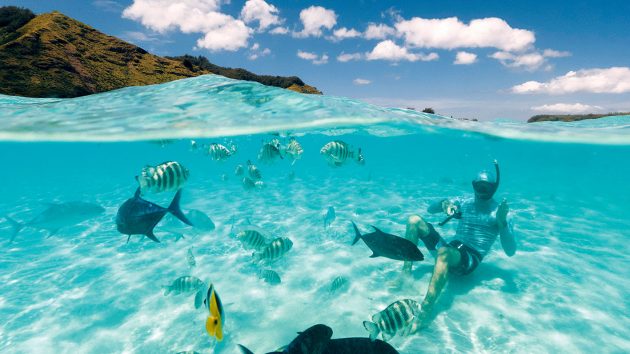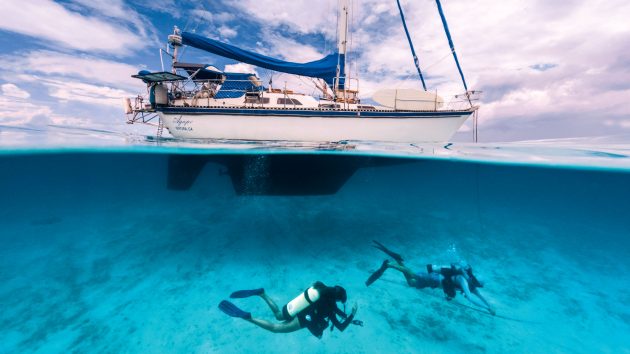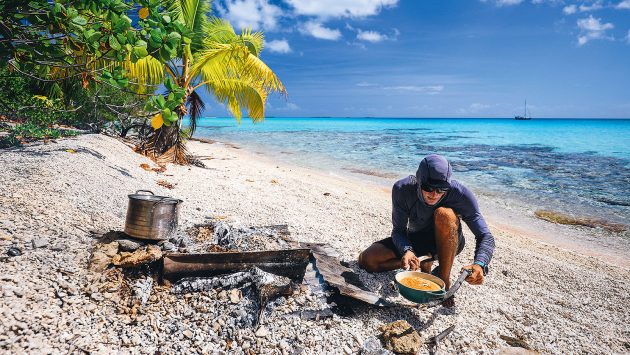Joshua Shankle and Rachel Moore’s first long-distance voyage takes them to French Polynesia where they explore the stunning scenery and remote atolls
Many sailors dream of setting out on a Pacific crossing with warm tropical trade winds blowing over the stern quarter, making for a beautiful 3,000 mile milk run.
This exotic South Pacific fantasy is usually filled with lush islands, flower-crowned dancers moving in hypnotic rhythm to the soft strum of a ukulele, and the sweet scent of tiara flowers drifting on the breeze.
For years, we worked on turning that dream into our reality. My wife, Rachel, and I spent two years cruising the Pacific coastline from our home port of Ventura, California, down Mexico, and through Central America to Panama.
We slowly built our confidence and fine-tuned our Tayana Vancouver 42, Agápe, preparing to make the voyage across the Pacific Ocean.
Exploring the wild coastline of Central America afforded us the experience of sailing in extremely diverse conditions, from rain-packed thunderstorms with 40-plus knots of wind to picture-perfect spinnaker runs.
We managed to encounter practically every type of sailing, anchoring, and navigating we thought we might come across in the remote islands of the South Pacific.
Our crossing turned out to be quite uneventful, and although painfully slow at times, it was one of the best sailing experiences we’ve had to date. We encountered the full gamut of weather, from drenching squalls lasting for hours, to an ocean so calm it mirrored the sky.

Predictably, we had beautiful trade-wind sailing for the majority of our passage, and even with Agápe grossly overloaded with fuel and supplies, we managed to make our best 24-hour run of 166 miles.
After 27 days of endless blue and constant motion, the excitement onboard was tangible. We could see land and our chart plotter finally read an ETA of hours, not days. It felt like we were ready to burst with a multitude of emotions.
We trimmed our sails, trying to get as much speed out of our 34-year-old sailboat as we could, anxious to enter the protected lagoon of Gambier and finally drop the hook in French Polynesia!
As our anchor plunged into the clear, turquoise water, all of the hard work, sacrifices and struggles it took to breathe life into this cruising dream suddenly felt insignificant.

It was love at first sight. We found ourselves immediately enamoured with French Polynesia, not only for its natural beauty, both above and below the water, but also for its
rich history, people and culture.
Undersea worlds in French Polynesia
Lying more than 800 miles south-southeast of the Marquesas and 900 miles from Tahiti, the local name of Mangareva, roughly translates to ‘separated or distant people’.

Being so far from the capital city of Pape’ete has kept the most pernicious effects of western influences at bay, and making landfall here the feeling of separation is palpable.
This small archipelago is made up of five tall volcanic islands and 18 smaller islets protected by a large barrier reef. While the hiking and snorkelling here are phenomenal, we found that learning about the local pearl farming industry to be the highlight.
Gambier is famed for its production of the Tahitian black pearl and its waters are full of oyster farms. There are so many that navigation can be a challenge. Long lines, buoyed by floats just below the surface of the water, suspend millions of oysters across the vast majority of the lagoon.
Rachel and I visited several farms during our six-week stay, learning how oysters are raised and pearls are created. We watched as pearls were seeded and harvested from the oysters, and try as we might to avoid temptation, we were captivated by the rich lustre of these little gems and ended up with a small treasure onboard.

As the season changed, we found ourselves a little too far south. When the coconut oil in our cupboard began to solidify, we knew it was time to continue our voyage to warmer waters.
Around 400 miles of wonderful trade-wind sailing, on a course to the northwest, are the low-lying islands that had filled my dreams for years – the Tuamotus.
The 76 ancient volcano calderas that make up this archipelago have all but been swallowed by the sea. Most are only a few metres above sea level, with palm trees jockeying for position in an otherwise endlessly blue skyline.
Nicknamed the dangerous archipelago, this is often sailors’ first experience with strong currents, manoeuvring through narrow passes, and anchoring in coral-filled lagoons.
The accuracy of modern charts and GPS has made navigation here much safer, though they are not to be fully trusted. For this reason, I have spent a fair number of hours at the bow or even sitting on the lower spreaders as a lookout, to help Rachel successfully navigate the lagoon and sneak into some truly spectacular anchorages.

The Paumotu people that inhabit these islands are warm and welcoming. While this is a French territory, it pays to remember the people living here are Polynesian, and learning a little of their language ensures a warm reception.
We often found ourselves in battles of generosity as we would gift fishing gear, solar lights, or other items, and in return would be blessed with lobster, coconut crabs, or beautifully presented fish.
These islands are where Robinson Crusoe dreams come true. Many are scarcely inhabited, or not at all, and cruising yachts can easily find secluded anchorages where days or weeks can drift by.
For the sporty sailor, a plethora of wind and watersports await. Surfing, kiteboarding, scuba diving, and spearfishing in the warm, crystalline waters here offer the perfect playground to hone your skills or learn new ones.
The lure of tranquility
After spending several months enjoying the vast undersea world of the Tuamotus, we were excited to finally set sail to Tahiti and the Society Islands.

As the commercial hub of French Polynesia, Tahiti is the land of plenty. Marine chandleries and large, well-stocked grocery stores abound in the ever-growing hustle and bustle of a modern metropolis. The juxtaposition of Pape’ete’s industrial port and the surrounding landscape is blaring.
While most boats use Tahiti as a place to refill the pantry, make necessary repairs and receive medical checkups before continuing on, this island should not be rushed.
Tahiti offers cultural sites, world-class diving, hiking and surfing – including the renowned surf break, Teahupo’o. And while there are enough unique activities to hold one’s attention for months or even years, the neighbouring island of Mo’orea’s tranquil call is often too much to resist.
Just an afternoon sail away, Mo’orea is the apogee of Polynesia. Over the past three years, we have spent more time anchored in its protected lagoon than any other.
It is, for us, the perfect blend of lush, tropical mountains, pristine reefs and modern conveniences. We have spent months hiking through the hills, valleys, and pineapple fields and have barely scratched the surface.
This island paradise is also one of the best places in the world to see migrating humpback whales, and it’s one of the few places left where you can still swim with these majestic giants.
Sailing further to the west takes you to the Leeward Islands of Huahine, Raiatea, Taha’a, Bora Bora and Maupiti. Like the other islands in French Polynesia, the Leewards are all different in their attractions and atmospheres. Our favourite of these, and possibly the best-kept secret in the Pacific, is Huahine.

Often referred to as the sacred or secluded island, this is one of the few that has resisted the influx of tourism. The vanilla-scented breeze is nearly as intoxicating as the relaxed and leisurely pace of life here. There are several mooring fields and great anchorages throughout the large and protected lagoon.
Below the surface, we found the water full of vibrant corals, anemones and colourful reef fish. Back on shore, the island is famous for its historical sites, unique ancient fish traps and sacred blue-eyed eels.
Renting bikes, if you don’t have them on board, is a great way to get off the boat, stretch your legs and discover the beauty of this haven at a more appropriate pace.
Even after three years of drifting around this Pacific playground, the spell cast by these Polynesian waters still holds firm over Agápe and her crew. We have been fortunate to wait out these turbulent times of the pandemic in such a pristine paradise.
As we wait for the borders of island nations to the west to reopen, we look forward to exploring the remaining two archipelagos of the Marquesas and Australs. These idyllic islands will continue to captivate us until we can carry on with our circumnavigation.
Tips for cruising French Polynesia
With the defined cyclone season between November and March, most of the 400 yachts leaving from the Americas will transit mid-March to early April.

If you hold a British passport, you don’t need a visa to enter French Polynesia for stays of up to three months, but you should check with the French Ministry of Foreign Affairs (www.france-visas.gouv.fr) for longer stays.
The majority of boats fly through French Polynesia on a three-month tourist visa. Unfortunately, gone are the days of simply hoisting a sail and letting the winds and seas be your guide.
Today, cruising involves a lot more bureaucracy and paperwork. To be approved for a temporary resident visa, also known as a Carte de Séjour, you must start the paperwork well before you cast off across the Pacific.
The hassle of getting this visa is well worth the time and meagre fees involved, as it gives you the most valuable resource: time. With so many islands to explore and activities to do, this visa, when properly renewed, can allow you to stay in French Polynesia for several years.
Many of our favourite islands and anchorages are well off the beaten path in an already distant and remote territory. While not absolute, it’s important for boats travelling here to be relatively self-sufficient.
Having solar panels or wind generators, a watermaker, and ample spares and food stores on board is a good idea, as supply ships ferrying goods to many of the outer islands can sometimes take weeks or months, and stocks can be sparse.
Enjoyed reading this?
A subscription to Yachting Monthly magazine costs around 40% less than the cover price.
Print and digital editions are available through Magazines Direct – where you can also find the latest deals.
YM is packed with information to help you get the most from your time on the water.
-
-
- Take your seamanship to the next level with tips, advice and skills from our experts
- Impartial in-depth reviews of the latest yachts and equipment
- Cruising guides to help you reach those dream destinations
-
Follow us on Facebook, Twitter and Instagram.





